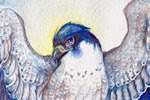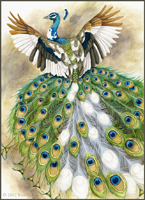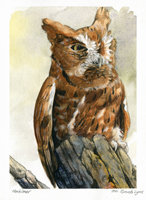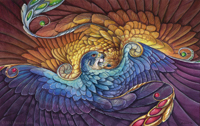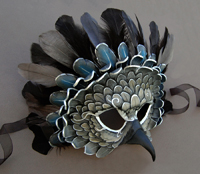Lately I've participated in a couple of the
Conceptart.org challenges, partially as a way to stretch my creative concept character challenges, and also because the challenges have had to do with Pokemon, and gryphons, both of which I couldn't turn down!
For the latest challenge, titled "
Glamorous Griffin", the challenge was to create the fanciest, most handsome, elaborate gryphon. The goal was to create a gryphon of any bird/mammal combination, with the goal of having the flashiest, most flamboyant plumage. As I like to explore subjects/techniques I haven't done before with these Creature of the Week challenges, I decided to go with a bird I rarely draw. Obviously raptors would be out of the question, and typical 'glamorous' birds such as parrots, peacocks and birds of paradise seemed to obvious. Well then, what better, under-appreciated beautiful bird should I choose?
Sketches
Pigeons, of course! These 'rats with wings' are often overlooked as city vermin, incorrectly feared for being dirty and full of disease. In truth, they are no dirtier or diseased than other wild animals, but people seem to hate them because of the mess they leave on cars and sidewalks. However, if one bothers to take a closer look, their necks shimmer with a variety of greens and purples, and their plumage often features soft lavenders and shades of blue-gray.
Using their subtle colors with touches of iridescence, I decided to enhance these colors and create a marvelous male in breeding plumage.
Color Sketch
I cleaned up the sketch and did a quick color sketch to establish plumage. I wanted to keep the overall grayed lavender color scheme, but with flashes of saturated iridescent colors to really make it pop. Though I usually do these challenges digitally, I decided to try this one in acrylic.
Background Wash and Sketch Transfer
I decided to use a piece of 9X12 inch acid-free matboard to paint on, both for the light-green color and for the texture. With an old, big bristle brush, I mixed a gray-green mixture of White, Black, Sap Green and a little Yellow Ochre, and painted a rough layer. Once dry, I went back with the same gray-green mixture, also mixing in some Raw Umber and Burnt Sienna. I didn't want the background to be too saturated, so I made sure to keep adding the gray-green. When the background was completely dry, I transferred my finished sketch. To give reason to his dance, I decided to add a bouquet of feathers that would float around him as he twirls.
Underpainting and Values
Still using grayed tones, I began loosely painting in colors. For the wings, I used a grayed mixture of Dioxazine Violet, and for the blues on the wings a gray mixture of Pthalo Blue. I aimed to keep my initial palette fairly limited, as I have a bad habit of getting too complex with my colors instead of focusing on how to make a few work well.
Building Value
Acrylics have the opposite problem of watercolors - instead of getting lighter as they dry, they get darker. I kept having to go back and add more and more white to areas I thought were light enough, as they got darker once dry. Still using only Dioxazine Violet, Pthalo Blue, and Black and White, I worked on pushing the values (with a little Pthalo Green for the neck). I tend to blend on the surface of the painting, so I often will use a 'dirty' brush to blend. At this point, I decided I would keep the far wing less contrasted to establish depth.
More Value and Building up Color
By pushing saturation only in certain areas, you create a more vibrant composition, whereas if everything was bright and vibrant, it wouldn't work as well. Overall I am pushing the colors only a little, save for highlighted areas. The tail plume, for example, I want very saturated so I used pure Pthalo Blue closest to the tip, then Dioxazine Violet, Permanent Rose, and finally Alizarin Crimson closest to the base all blended on the surface. While still wet, I went in with white to get that iridescent blue sheen on the end of the tail tuft.
At this point, I had built up my values to the point where I really only needed to use thin glazes to add color. Cadmium Yellow, for example, is quite translucent but very bright, so just a little over the primary feathers was enough to saturate them. I built up the edges of the primary feathers with Pthalo Blue mixed with a little black, then used light layers of Permanent Rose to build up the purple. At this point, I am building up the last of the value while adding color, as certain pigments are more opaque than others, and need to be mixed with white or black.
Finished Painting
Mixing a bit more of my original gray-green mixture, I used black and Dioxazine Violet for the shadow under the gryphon, blending roughly into the background for texture. I added a few splashes of Burnt Sienna, Yellow Ochre and Raw Umber to add just a little color to the background, still keeping it mostly gray, and lightened the upper left with a bit of white. The important part here is to keep the focus and vibrancy on the gryphon - if there's too much color in the background, it will complete with your subject!
The iridescent spots were actually not challenging at all to paint. I painted the spots with Pthalo Blue mixed with black, let dry completely, then painted over with pure Pthalo Blue. While still wet, I took a small brush loaded with white and smeared the wet blue, creating a subtle 'shine'. I went back with a glaze of Green Gold to add a little extra color, and used a very thin layer of Green Gold for the green on the neck. For the blue, I used a very thin layer of Pthalo Blue, and for the purple, just a hint of Alizarin Crimson mixed with Permanent Rose. Because I had built the value up before, the glazes had a good foundation and didn't need any additional work to create the illusion of iridescence.
The floating feathers are a mixture of the colors I had already been using. Here's a complete list of the colors that went into this painting:
Alizarin Crimson
Permanent Rose
Cadmium Yellow
Yellow Ochre
Sap Green
Green Gold
Pthalo Green
Pthalo Blue
Dioxazine Violet
Burnt Sienna
Raw Umber
Mars Black
Titanium White







































